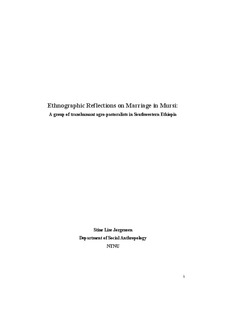Ethnographic Reflections on Marriage in Mursi: A group of transhumant agro-pastoralists in Southwestern Ethiopia
Master thesis
Permanent lenke
http://hdl.handle.net/11250/271353Utgivelsesdato
2011Metadata
Vis full innførselSamlinger
Sammendrag
This thesis is the outcome of a fieldwork which I carried out among the Mursi people of Southwestern Ethiopia from January until June 2010. The Mursi are transhumant agropastoralists and inhabit an area marked by long periods of drought. Over the past few decades they and their neighbors` livelihood have first and foremost been threatened by the growing shortage of water in dry-season grazing areas. As a result there has been a northward migration within Mursiland. Moreover, there are also other underlying factors for the migration, such as intermarriage. In this matter I shortly discuss the various impacts and challenges which the Mursi people face in every day life. However, the main focus for this work is that of kinship and marriage. I argue that Mursi marriage may be looked upon as a total social phenomenon, as all the various institutions within the Mursi society play a part in constituting a Mursi marriage.
The Mursi kinship system is patrilineal, which is ancestor focused, meaning that kin is reckoned through one common male ancestor. However, as the Mursi kinship system is based on classificatory kin relations, there is no socially significant difference between various relations of kin categories. These categories are important in the Mursi bridewealth payments, which is ideally 38 head of cattle for a Mursi woman. The ideal distribution of bridewealth is important in the recurring of kinship ties, as a Mursi man is included in a debt lasting for three generations. I focus on showing how ties of kinship create solidarity between groups, and break down when the bridewealth payment has come to and end. However, the bridewealth rules allow the kinship ties to reappear. I also discuss the importance in cattle and how they are used as a tool in acquiring a wife, not the other way around as the "cattle complex" suggested in East African studies during the 1920s.
